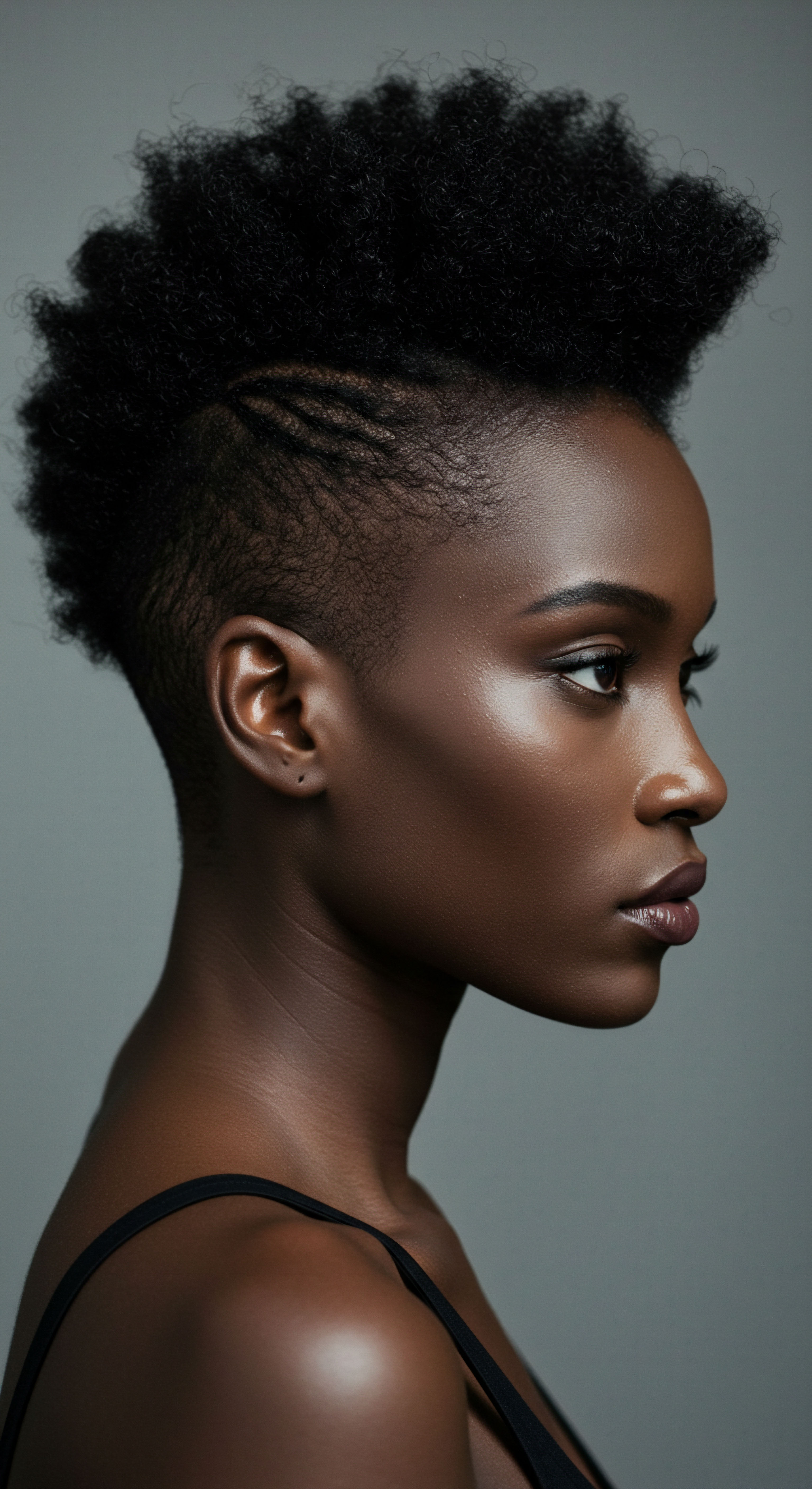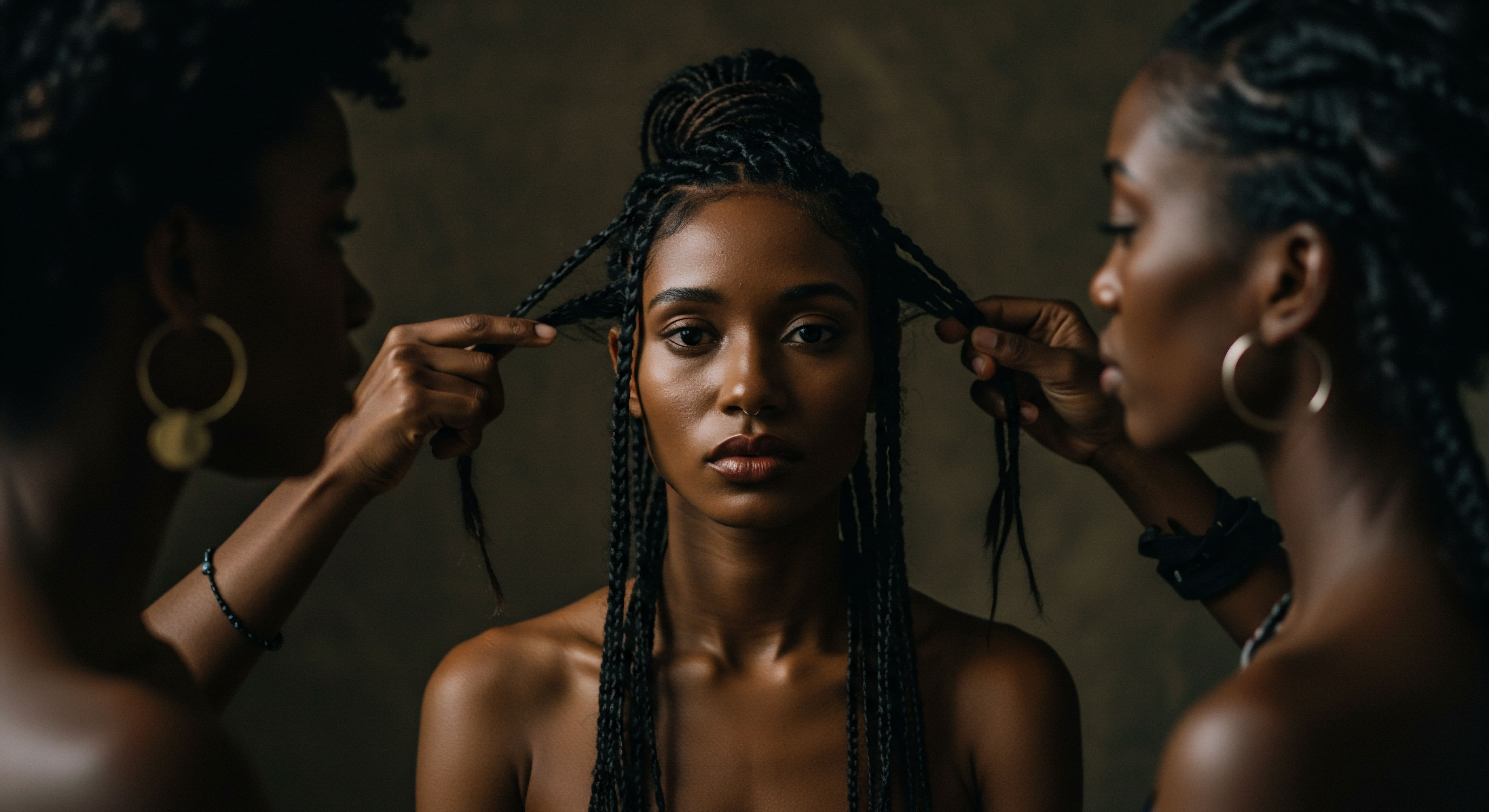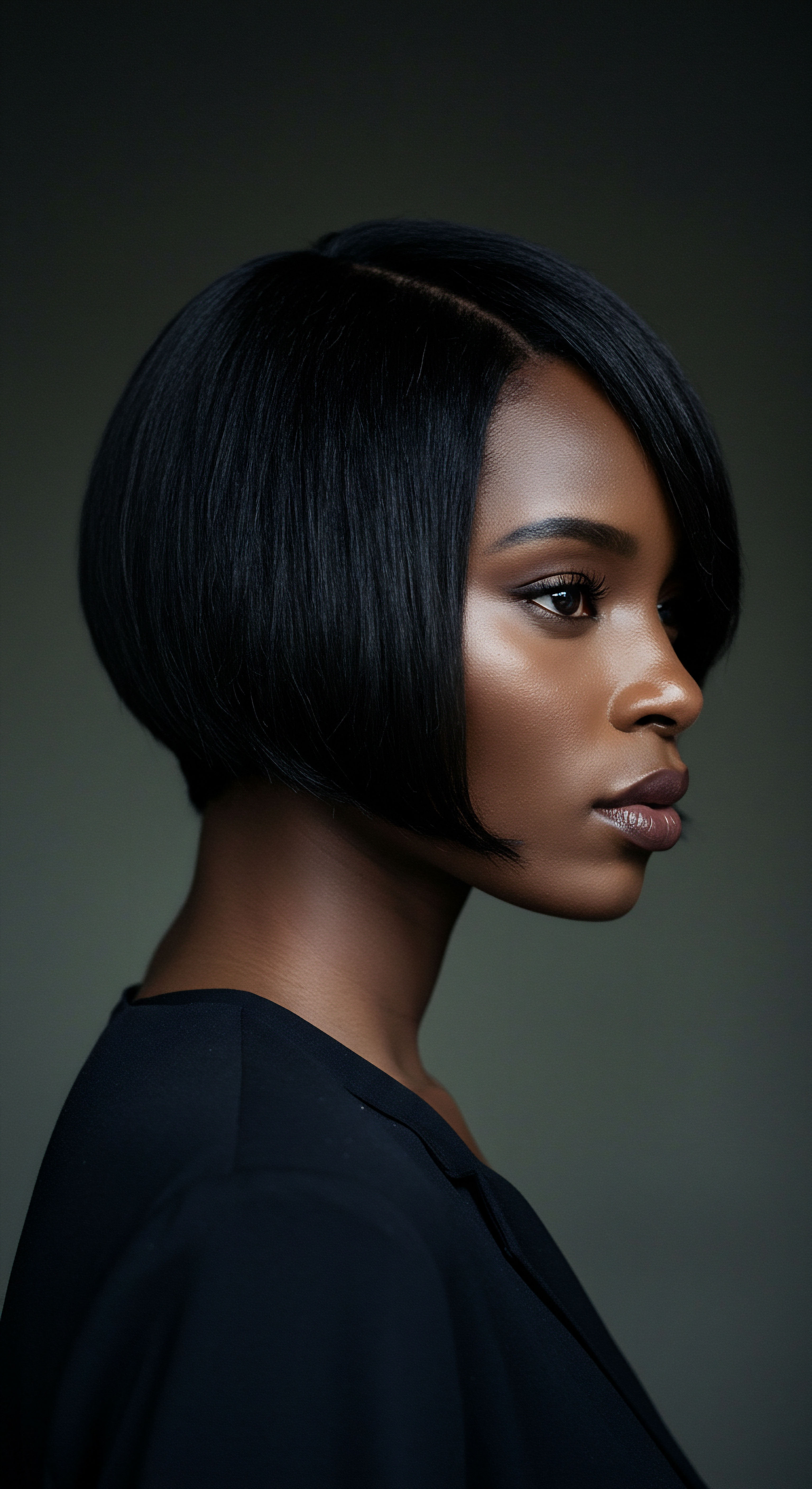
Roots
Consider for a moment the quiet strength held within a single strand of hair, or the silent language spoken by a sculpted coil. Before the profound shifts brought by colonial rule, hair in Africa was seldom a mere adornment. It served as a vibrant canvas, reflecting the deepest truths of an individual and their place within the collective.
From birth to elderhood, through joy and sorrow, the hair was a living testament to one’s lineage, social standing, spiritual beliefs, and even their aspirations. This understanding forms the bedrock of how hair care practices became deeply intertwined with communal bonds across the continent.
Across diverse pre-colonial African societies, hair carried layers of meaning, acting as a profound form of non-verbal communication. It was a physical marker, a living symbol that articulated one’s identity within a group. The way hair was styled, adorned, or treated could signify a person’s age, marital status, ethnic identity, wealth, and rank.
For instance, in the Wolof community of Senegal, young girls might wear partially shaved heads to signal they were not yet courting, a visual cue understood by all within the community. Such practices created an immediate, shared understanding of social roles and individual life stages, fostering a sense of belonging and collective identity.

Hair as a Living Identifier
The hair, being the most elevated part of the human body, was often regarded as a sacred connection to the divine and ancestral realms. This spiritual significance meant that hair care was not taken lightly; it was a practice imbued with reverence and often entrusted to those held in high esteem, typically close relatives or skilled community members. This belief system naturally brought people together, creating intimate spaces where care and spiritual connection converged. The careful styling of hair, therefore, transcended mere aesthetics, becoming a communal act of respect, both for the individual and for the spiritual forces believed to reside within the strands.
Each twist, braid, or adornment told a story, a complex message decipherable by those who shared the cultural codes. The styles were not arbitrary; they were meticulously crafted expressions of identity.
- Tribal Affiliation ❉ Different clans and ethnic groups often possessed unique hairstyles, making it possible to identify one’s origins at a glance. The Himba tribe in Namibia, for example, used dreadlocked styles coated with red ochre paste, a direct link to their connection with the earth and their ancestors.
- Social Status ❉ The complexity and ornamentation of a hairstyle could indicate a person’s standing within the community, with leaders and royalty often sporting the most elaborate coiffures.
- Life Stages ❉ Hair styles often marked significant transitions, such as puberty, marriage, or mourning. A woman’s hair might change from loose styles to braids or cornrows upon marriage in some cultures.

Shared Understanding of Hair’s Meaning
The collective understanding of these visual cues reinforced social cohesion. Everyone understood the silent language of hair, allowing for seamless interaction and recognition within the community. This shared knowledge acted as a powerful social glue, reinforcing norms, expectations, and the interconnectedness of individual lives.
When hair was neglected or styled inappropriately, it could signal distress or deviance, prompting communal concern and intervention. This collective awareness underscored the communal responsibility for individual well-being, where one’s appearance, particularly their hair, was a reflection of the community’s overall health and order.
Hair in pre-colonial Africa was a living language, communicating identity, status, and spiritual connections within the community.

Ritual
Stepping from the foundational understanding of hair’s meaning, we now consider the practical wisdom embedded in daily and periodic hair care. The methods and moments dedicated to styling hair in pre-colonial Africa were far from solitary endeavors; they were often vibrant social occasions, fostering shared experiences and solidifying relationships. The gentle tug of a comb, the rhythmic sound of braiding, the shared laughter, and whispered confidences transformed hair care into a communal ritual, a cornerstone of social life.

Communal Grooming Sessions
Hair grooming sessions were typically communal activities, particularly among women. These were not simply tasks to be completed, but cherished opportunities for social interaction and bonding. Mothers styled their daughters’ hair, grandmothers shared traditional techniques with younger generations, and friends gathered to help each other with intricate styles that might take hours or even days to complete. These gatherings provided a space for:
- Intergenerational Knowledge Transfer ❉ Elders passed down not only styling techniques but also stories, cultural norms, and ancestral wisdom. The practical skill of braiding or coiling became a vehicle for transmitting cultural heritage, ensuring continuity across generations.
- Social Support and Communication ❉ During these extended sessions, individuals exchanged news, discussed community matters, offered advice, and simply enjoyed each other’s company. This intimate setting facilitated open communication and emotional support, strengthening interpersonal ties.
- Shared Labor and Mutual Aid ❉ Many complex hairstyles required multiple hands. The act of helping another person with their hair was a tangible expression of care and cooperation, reinforcing mutual dependence and collective responsibility within the group.

What Were the Tools and Techniques Employed in Communal Hair Care?
The tools themselves, often crafted from natural materials like wood, bone, or ivory, were extensions of this communal practice. Combs, pins, and razors were designed with the specific textures of African hair in mind, often featuring long teeth and rounded tips for detangling and shaping. The preparation of hair care products, such as oils, clays, and herbal infusions, also involved communal effort, with knowledge of local botanicals passed down through families and communities. These preparations were not just about aesthetics; they often held medicinal or protective properties, further underscoring the holistic approach to hair care that encompassed well-being beyond mere appearance.
Hair care rituals in pre-colonial Africa served as vital social hubs, fostering intergenerational learning and communal support.
Consider the meticulous process of applying red ochre paste to Himba dreadlocks, a practice that takes considerable time and communal effort. This daily ritual, involving the mixing of ochre, butter, and sometimes goat hair, is a shared activity, particularly among women, solidifying their collective identity and connection to their environment. The visible outcome is a striking, uniform appearance that immediately identifies members of the Himba, but the process itself is equally important in reinforcing their social structure and shared values.
| Practice Braiding Sessions |
| Description Intricate plaiting often requiring multiple individuals and many hours. |
| Communal Benefit Facilitated storytelling, gossip, advice sharing, and strengthened female bonds. |
| Practice Application of Natural Products |
| Description Use of clay, oils, herbs, and ochre for conditioning and styling. |
| Communal Benefit Shared knowledge of local botanicals, collective preparation of ingredients, and mutual care. |
| Practice Head Shaving Rituals |
| Description Specific patterns or complete shaving for rites of passage or mourning. |
| Communal Benefit Marked collective life transitions, shared grief, and reaffirmation of spiritual connection. |
| Practice Adornment with Ornaments |
| Description Decorating hair with beads, shells, cowrie shells, or metal. |
| Communal Benefit Displayed collective wealth, status, and tribal identity through shared aesthetic values. |
These communal aspects of hair care transcended simple beauty routines; they were integral to the daily rhythm of life, providing consistent opportunities for individuals to connect, learn, and reinforce their collective identity. The physical act of caring for another’s hair became a profound expression of social solidarity, weaving individuals into the larger fabric of their community.

Relay
How deeply did hair practices truly reinforce social structures and collective identity in pre-colonial Africa? Beyond the visible bonds of shared grooming, hair care was a sophisticated mechanism, a subtle yet powerful tool for social organization and the perpetuation of cultural norms. This deeper analysis reveals how hair served not only as a reflection of existing hierarchies but also as an active participant in their maintenance and transmission, a testament to the intricate relationship between personal adornment and societal cohesion.

Hair as a System of Social Communication
In many pre-colonial African societies, hair functioned as a complex, dynamic system of communication, providing instant visual cues about an individual’s place within the social order. This system was so refined that it could convey a multitude of details without a single spoken word.
- Age and Seniority ❉ Different hairstyles were often associated with specific age groups, marking transitions from childhood to adolescence, adulthood, and elder status. For instance, in some communities, elaborate styles were reserved for those who had achieved a certain level of maturity or wisdom.
- Marital and Familial Status ❉ Hair could clearly indicate if someone was single, married, widowed, or even pregnant. A woman’s hair might be styled differently to signify her availability for marriage, her status as a new mother, or her period of mourning. Among the Akan of Ghana, the hairstyle and costuming could easily identify a widow.
- Occupational or Ceremonial Roles ❉ Certain styles were specific to warriors, priests, healers, or those participating in particular ceremonies. These styles were not merely decorative; they conveyed authority, spiritual connection, or a specific function within the community.
This intricate visual language ensured that every interaction was framed by an immediate understanding of social context. Individuals knew how to address one another, who held authority, and what roles were being performed, all communicated through the silent dialogue of hair. This pervasive system of non-verbal communication significantly contributed to the stability and order of communal life.
Beyond aesthetics, hair served as a sophisticated social lexicon, guiding interactions and reinforcing societal structures.

What Scientific or Anthropological Insights Support Hair’s Role in Pre-Colonial Social Cohesion?
Anthropological research provides compelling insights into the functional and symbolic roles of hair. Studies have documented how hair practices were instrumental in maintaining social order and reinforcing collective identity. For example, in her book “Carving Up Beauty ❉ An Examination of the Socio-Cultural Origins of the Feminine Beauty Ideal in Pre-Colonial Yorubaland,” Amber Jackson explores how beauty ideals, including hairstyles, reinforced acceptable patterns of behavior, gender dynamics, and gendered notions of success among the Yoruba people.
The acceptance and adherence to these beauty standards indicated conformity and social belonging, making beauty a tool for social control and maintenance. This research highlights that hair was not simply a personal choice but a powerful mechanism for social integration, where deviating from established norms could signal a lack of conformity or belonging.
A particularly compelling case study comes from the historical accounts of the transatlantic slave trade, which, while post-dating the “pre-colonial” era, dramatically underscores the pre-existing communal significance of hair. Slave traders often forcibly shaved the heads of enslaved Africans upon capture. This act was not merely for hygiene; it was a deliberate, dehumanizing strategy to strip individuals of their identity, sever their connection to their cultural roots, and break their spirit. The very effectiveness of this brutal act in disorienting and isolating individuals speaks volumes about how deeply hair was embedded in communal identity and social cohesion in their homelands.
The loss of these visual markers, which communicated tribal affiliation, social status, and personal history, left individuals feeling anonymous and disconnected, highlighting the profound role hair played in their sense of community and self. This historical context serves as a stark, albeit inverse, demonstration of hair’s foundational role in maintaining communal bonds.
Moreover, the communal practice of hair care was not merely about shared time; it had economic and political dimensions. In some societies, skilled hairstylists held significant social standing and were compensated for their expertise, creating a specialized role within the community. The exchange of services and knowledge contributed to local economies and reinforced social hierarchies based on skill and craft. The materials used for adornment, such as rare beads, shells, or precious metals, also reflected trade networks and economic prosperity, further integrating hair practices into the broader societal structure.
| Aspect of Society Social Hierarchy |
| Hair's Role Complex styles for royalty/leaders. |
| Societal Reinforcement Visual affirmation of power and authority. |
| Aspect of Society Life Transitions |
| Hair's Role Specific styles for puberty, marriage, mourning. |
| Societal Reinforcement Public acknowledgment and collective support for individual life stages. |
| Aspect of Society Cultural Identity |
| Hair's Role Distinct tribal patterns and adornments. |
| Societal Reinforcement Strengthened group solidarity and differentiation from other communities. |
| Aspect of Society Economic Exchange |
| Hair's Role Skilled stylists and trade of adornment materials. |
| Societal Reinforcement Supported specialized labor and regional trade networks. |
The intentional disruption of these hair practices during periods of enslavement and colonialism further underscores their importance. The forced shaving of heads was an act of cultural violence, designed to dismantle the very foundations of communal identity and resistance. The subsequent efforts by African people and their descendants to reclaim and re-establish traditional hairstyles stand as a powerful testament to the enduring communal significance of hair, even in the face of immense adversity. These acts of reclamation are not merely about personal aesthetics; they are profound statements of collective resilience and a reassertion of heritage.

Reflection
As we consider the profound role of hair care in pre-colonial Africa, a deeper understanding emerges ❉ it was a practice imbued with far more than surface beauty. The intricate braiding, the careful adornment, the shared moments of styling, all contributed to a rich tapestry of communal life. These practices were not isolated acts of self-adornment but rather vibrant, living expressions of collective identity, social order, and spiritual connection.
The hair, in its diverse forms and styles, served as a silent, yet eloquent, chronicle of a people’s history, their values, and their interconnectedness. The echoes of these ancient traditions resonate still, reminding us of the enduring power of hair to bind individuals to their heritage and to one another.

References
- Byrd, A. D. & Tharps, L. (2014). Hair Story ❉ Untangling the Roots of Black Hair in America. St. Martin’s Press.
- Jackson, A. (2014). Carving Up Beauty ❉ An Examination of the Socio-Cultural Origins of the Feminine Beauty Ideal in Pre-Colonial Yorubaland. Scholars’ Press.
- Johnson, K. & Bankhead, A. (2014). Black Hair and Hair Texture ❉ Cultivating Diversity and Inclusion for Black Women in Higher Education. Emerald Insight.
- Kedi, C. (2018). Beautifying the Body in Ancient Africa and Today. Books of Africa.
- Matshego, L. (2020). A History of African Women’s Hairstyles. Africa.com.
- Omotos, A. (2018). The History of African Hair. Journal of Pan African Studies.
- Sieber, R. & Herreman, F. (2000). Hair in African Art and Culture. Museum for African Art.
- Simkins, A. A. (1982). The functional and symbolic roles of hair and headgear among Afro-American women ❉ a cultural perspective. The University of North Carolina at Greensboro.
- Tawe, E. (2021). Transmission. Khumbula.
- Tharps, L. (2001). Hair Story ❉ Untangling the Roots of Black Hair in America. St. Martin’s Press.